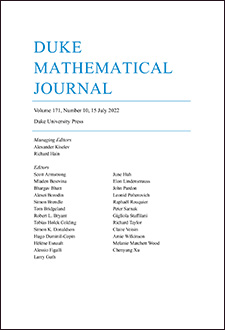Abstract
Let $M$ be a compact manifold without boundary. Associated to a metric $g$ on $M$ there are various Laplace operators, for example, the de Rham Laplacian on $p$-forms and the conformal Laplacian on functions. For a general geometric differential operator of Laplace type with eigenvalues 0≤λ1≤λ2≤⋯, we consider the spectral zeta function $Z(s)=\sum_{\lambda_j\neq0} \lambda_j^{-s}$. The modified zeta function $\mathcal{Z}(s)=Γ(s)Z(s)/Γ(s−n/2)$ is an entire function of $s$. For a fixed value of $s$, we calculate the Hessian of $\mathcal{Z}(s)$ with respect to the metric and show that it is given by a pseudodifferential operator Ts=Us+Vs, where $U_s$ is polyhomogeneous of degree n−2s and Vs is polyhomogeneous of degree 2. The operators $U_s/Γ(n/2+1−s)$ and $V_s /Γ(n/2+1−s)$ are entire in $s$. The symbol expansion of $U_s$ is computable from the symbol of the Laplacian. Our analysis extends to describing the Hessian of $(d / ds)^k \mathcal{Z}(s)$ for any value of $k$.
Citation
K. Okikiolu. "Hessians of spectral zeta functions." Duke Math. J. 124 (3) 517 - 570, 15 September 2004. https://doi.org/10.1215/S0012-7094-04-12433-9
Information





